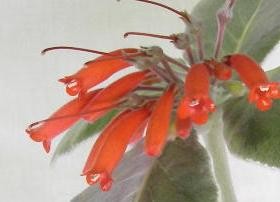Sinningia macrostachya
(Sinningia macrostachya)

Description
Sinningia macrostachya is a species of Magnoliopsida first described by John Lindley, and given the simplified Asian name by Chautems. Sinningia macrostachya belongs to the genus Sinningia, and the family Gesneriaceae. Sinningia is a genus of flowering plants in the family Gesneriaceae. It is named after Wilhelm Sinning (1792–1874), a gardener of the Botanische Gärten der Friedrich-Wilhelms-Universität Bonn. There are about 65 species of tuberous herbaceous perennials, all occurring in Central and South America, with the greatest concentration of species occurring in southern Brazil. The best-known species, Sinningia speciosa, was originally introduced in cultivation as Gloxinia speciosa and is still commonly known to gardeners and in the horticultural trade as "gloxinia", although this is now considered incorrect. The true genus Gloxinia is distinguished by having scaly rhizomes rather than tubers. Sinningia species often grow on rocks or cliffs and most are pollinated by hummingbirds or bees but Sinningia brasiliensis is bat-pollinated, and Sinningia tubiflora, with large, powerfully fragrant tubular white flowers, is apparently pollinated by sphinx moths. Most of the species have large, brightly colored flowers. Because of this, numerous species and numerous hybrids and cultivars are grown as houseplants. A cultivar worth knowing is Sinningia x 'Lovely.' This beautifully gentle plant is a cross between Sinningia sellovii and Sinningia tubiflora. Its tall spikes and tubular flowers attract butterflies, and delight gardeners. Some species with particularly large tubers are cultivated by cactus and succulent enthusiasts as caudiciforms. One such example is Sinningia leucotricha, often listed under the older name Rechsteineria leucotricha and dubbed "Brazilian edelweiss" for its covering of silvery, silky hairs. Other species with large tubers are Sinningia iarae, Sinningia lineata, and Sinningia macropoda. The Brazilian genera Paliavana and Vanhouttea, consisting of shrubby plants without tubers, are closely related to Sinningia and recent morphological and molecular analyses (Boggan 1991, Perret et al. 2003) suggest that these genera are, in fact, nontuberous Sinningia species. All three genera were included in tribe Gloxinieae in the classification system of Hans Wiehler but are now recognized in their own tribe, Sinningieae. Numerous genera, including Corytholoma, Rechsteineria and Lietzia, have been synonymized under Sinningia.
Taxonomic tree:







